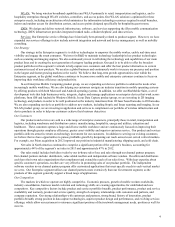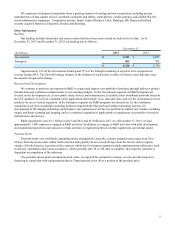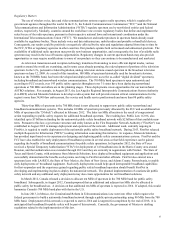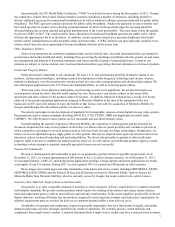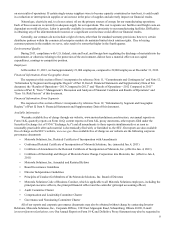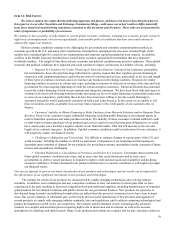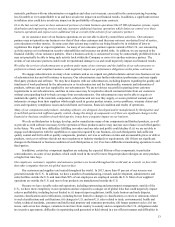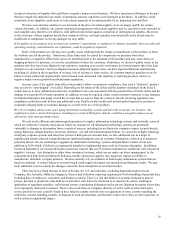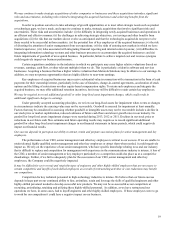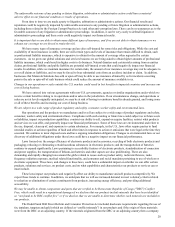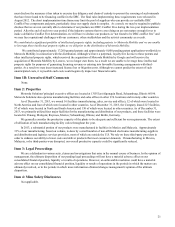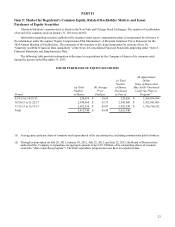Motorola 2013 Annual Report Download - page 16
Download and view the complete annual report
Please find page 16 of the 2013 Motorola annual report below. You can navigate through the pages in the report by either clicking on the pages listed below, or by using the keyword search tool below to find specific information within the annual report.14
securing local country approvals for cash repatriations; (v) currency fluctuations; (vi) changes in foreign exchange regulations;
(vii) challenges in collecting accounts receivable; (viii) cultural and language differences; (ix) employment regulations and
local labor conditions; (x) difficulties protecting intellectual property in foreign countries; (xi) instability in economic or
political conditions, including inflation, recession and actual or anticipated military or political conflicts; (xii) natural disasters;
(xiii) public health issues or outbreaks; (xiv) changes in laws or regulations that negatively impact benefits being received by us
or that require costly modifications in products sold or operations performed in such countries; and (xv) litigation in foreign
court systems and foreign administrative proceedings.
Many of our products that are manufactured by us outside the U.S. are manufactured in Asia (primarily Malaysia) and
Latin America (primarily Mexico). If manufacturing in these regions is disrupted, our overall capacity could be significantly
reduced and sales or profitability could be negatively impacted.
We have a number of employees in and sell our products and services throughout the Middle East and our operations, as
well as demand for our products and services could be negatively impacted by political conflicts and hostilities in this region.
The potential for future unrest, terrorist attacks, increased global conflicts and the escalation of existing conflicts has created
worldwide uncertainties that have negatively impacted, and may continue to negatively impact, demand for certain of our
products.
We also are subject to risks that our operations could be conducted by our employees, contractors, representatives or
agents in ways that violate the Foreign Corrupt Practices Act, the U.K. Bribery Act, or other similar anti-corruption laws. While
we have policies and procedures to comply with these laws, our employees, contractors, representatives and agents may take
actions that violate our policies. Any such violations could have a negative impact on our business. Moreover, we face
additional risks that our anti-corruption policies and procedures may be violated by third-party sales representatives or other
third-parties that help sell our products or provide other solutions and services, because such representatives or agents are not
our employees and it may be more difficult to oversee their conduct.
We may not continue to have access to the capital markets for financing on acceptable terms and conditions, particularly if our
credit ratings are downgraded.
From time to time we access the capital markets to obtain financing. Our access to the capital markets and the bank
credit markets at acceptable terms and conditions are impacted by many factors, including: (i) our credit ratings, (ii) the
liquidity of the overall capital markets, (iii) strength and credit availability in the banking markets, and (iv) the current state of
the economy. There can be no assurances that we will continue to have access to the capital markets or bank credit markets on
terms acceptable to us.
We are rated investment grade by all three national rating agencies. Any downward changes by the rating agencies to our
credit rating may negatively impact the value and liquidity of both our debt and equity securities. Under certain circumstances,
an increase in the interest rate payable by us under our revolving credit facility could result. In addition, a downgrade in our
credit ratings could limit our ability to: access the capital markets or bank credit markets; provide performance bonds, bid
bonds, standby letters of credit and surety bonds; hedge foreign exchange risk; fund our foreign affiliates; and sell receivables.
A downgrade in our credit rating could also result in less favorable trade terms with suppliers. In addition, any downgrades in
our credit ratings may affect our ability to obtain additional financing in the future and may affect the terms of any such
financing. Any future disruptions, uncertainty or volatility in the capital markets may result in higher funding costs for us and
adversely affect our ability to access funds and other credit related products. In addition, we may avoid taking actions that
would otherwise benefit us or our stockholders, such as engaging in certain acquisitions or engaging in stock repurchases, that
would negatively impact our credit rating.
Returns on pension and retirement plan assets and interest rate changes could affect our earnings and cash flow in future
periods.
We have large underfunded pension obligations, in part resulting from the fact that we retained almost all of the U.S.
pension liabilities and a major portion of our non-U.S. pension liabilities following our divestitures, including the distribution
of Motorola Mobility and the sale of our Networks business. The funding position of our pension plans is affected by the
performance of the financial markets, particularly the equity and debt markets, and the interest rates used to calculate our
pension obligations for funding and expense purposes. Minimum annual pension contributions are determined by government
regulations and calculated based upon our pension funding status, interest rates, and other factors. If the financial markets
perform poorly, we have been and could be required to make additional large contributions. The equity and debt markets can be
volatile, and therefore our estimate of future contribution requirements can change dramatically in relatively short periods of
time. Similarly, changes in interest rates can affect our contribution requirements. In volatile interest rate environments, the
likelihood of material changes in the future minimum required contributions increases.
A significant amount of our international business is transacted in local currency and a large percentage of our cash and cash
equivalents are held outside of the United States, which exposes us to risk relating to currency fluctuations, changes in foreign


